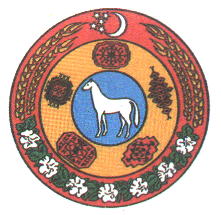
Turkmenistan Government,
Turkmenistan Ministry of Foreign Affairs.
Institute of History attached to Cabinet of Ministers of
Turkmenistan.
Russian Society for Cultural Relations with Turkmenistan (St.
Petersburg).
Friendship Society "Turkmenistan-Russia" (Ashgabad)
International Conference
"Cultural Heritage of Turkmenistan: Deep Origins and Modern Prospects",
Ashgabad, Turkmenistan Republic.

On the character of the Parthian Zoroastrianism (upon some Parthian and Pahlavi sources)
Summary
Arthur Ambartsumian (St. Petersburg)
This paper deals with the problem of determination of the Parthian religion or the Parthian (Arsacid) variety of Zoroastrianism. Observation of this problem is based on some Parthian and Pahlavi sources, such as analysis of the Parthian names from the Old Nisa archives, accounts from the Pahlavi Zoroastrian books, evidences from the Sassanian literary writings of the Parthian origin: "Ayadgar i Zareran" (Memorial of Zarer) and "Drakht i asurig ud buz" (Date-tree and goat). The analysis of the Parthian names from the Old Nisa archives proves that the Parthians worshiped the following Zoroastrian divinities: Mihr (Mithra), Ohrmazd (Ahura-Mazda), Arta (Asha), Den (Daena), Ram (Rama), Rashn (Rashnu), Srosh (Sraosha), Tir (Tishtrya), Varahran (Verethragna) . Such reconstruction derives from the most typical names: Mihrdat, Ohrmazdik, Artapan, Denich, Ramenak, Rashn, Sroshdatak, Tiridat, Warahragn, and so on. Some names such as Spandarmat, Wohuman and Artawahisht prove that the Parthians recognized the holy immortal Zoroastrian archangels, the Ameshaspentas Spenta-Armaiti, Vohumana and Artavahishta.
According to the Pahlavi Zoroastrian book Denkard (Denkard IV.16), the revival of the Zoroastrian religious literature (Abastag ud Zand - Avesta and Zand) has begun during the rule of the Parthian Arsacid king Vologezes (Walakhsh i Ashkanan) . The Denkard preserved also an account on the Zoroastrian priests of the Seleucid and Arsacid periods: Arezwag, Srudog-spadag, Zrayanh, Spendo-khradwo (Denkard VII.7.5-11). Their original names are also known from the memorial part of the Avestan Fravardin Yasht: Erezva, Sruta-spada, Zrayanha and Spento-khratu (Yasht 13.115). These Zoroastrian priests were encountered in a religious controversy with an apostate and heretic Rashn-resh ("someone who harms Rashn, the divinity of justice").
Middle Persian (Pahlavi) Sassanian writings of the Parthian origin "Ayadgar i Zareran" (Memorial of Zarer) and "Drakht i asurig ud buz" (Date-tree and goat) confirm that an orthodox type of Zoroastrianism might be existing in Parthian times. Thus, "Ayadgar i Zareran" celebrating the tragical and triumphal events of the great war with the Hyon adversary, tells about the adoption of the Zoroastrian faith by the Eranian king Kay-Wishtasp. Zoroastrian faith is called here as "the Mazdayasnian unblemished faith" (dÍn Ó abÍzag Ó m‚zd‚sn‚n) . The poem "Drakht i asurig ud buz" mentions many Zoroastrian themes and glorifies the adoption of the faith in creator Ohrmazd. The faith is called here as "unblemished Mazdayasnian faith" (abÍzag dÍn Ó m‚zdÍsn‚n).
Nevertheless, the local Zoroastrian faith in the Nisa region of Parthia, as it is shown by the reconstructed divine names, should be characterized as a n orthern type of Zoroastrianism. Northern Iranian tribes such as Parthians, Dahas and Aparnis, while adopting the faith in Ohrmazd, continued to worship their local divinities in a pagan way. As it seems they glorified predominantly the Aryan Khvarenah ( cf. the names from Nisa: Aryabarzan, Aryashahrak, Aryamihrak, Aryafrianak). Conventionally the southern type of Zoroastrianism, with glorification of the Kavian Khvarenah and other local divinities, was spread not in proper Parthia, but in other Iranian provinces (Sakastan).